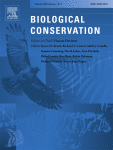Threat-dependent traits of endangered frogs
Ruland F, Jeschke JM – 2017
Numerous studies have investigated life-history and other traits of endangered species for conservation purposes. These studies typically look for universal traits independently of the reasons why species are threatened. The usefulness of such analyses is limited if the traits are actually threat-dependent, but whether that is the case is currently unknown. We investigated if two traits of anurans – snout-vent length and habitat breadth – are threat-dependent, using the threats human consumption and pet trade as case examples. Analysing a unique global dataset (1041 species with data on snout-vent length and 4103 species with data on habitat breadth), we show that the traits of endangered anurans are strongly threat-dependent. For instance, while snout-vent length is similar between threatened and non-threatened frogs when not discriminating between threats, distinct differences become apparent when considering the reasons why the species are threatened: frogs threatened by human consumption have large body sizes, whereas those threatened by the pet trade are small. Thus at least for frogs, searching for universal traits of endangered species independently of the reasons why they are threatened does not seem to be rewarding. Instead, we need to better understand the relationship between the traits of endangered species and the reasons why they are threatened. This will help better predicting which species will become more critically endangered (or can recover) if certain threats will increase (or decrease) in their magnitude in the future.

